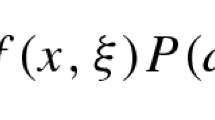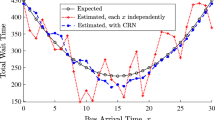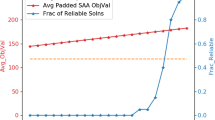Abstract
We investigate the quality of solutions obtained from sample-average approximations to two-stage stochastic linear programs with recourse. We use a recently developed software tool executing on a computational grid to solve many large instances of these problems, allowing us to obtain high-quality solutions and to verify optimality and near-optimality of the computed solutions in various ways.
Similar content being viewed by others
References
Anstreicher, K., N. Brixius, J.-P. Goux, and J.T. Linderoth. (2002). “Solving Large Quadratic Assignment Problems on Computational Grids.” Mathematical Programming 91(3), 563–588.
Avramidis, A.N. and J.R. Wilson. (1996). “Integrated Variance Reduction Strategies for Simulation.” Operations Research 44, 327–346.
Bailey, T.G., P. Jensen, and D.P. Morton. (1999). “Response Surface Analysis of Two-Stage Stochastic Linear Programming With Recourse.” Naval Research Logistics 46, 753–778.
Chen, Q., M.C. Ferris, and J.T. Linderoth. (2001). “Fatcop 2.0: Advanced Features in an Opportunistic Mixed Integer Programming Solver.” Annals of Operations Research 103, 17–32.
Dantzig, G. and G. Infanger. (1991). “Large-Scale Stochastic Linear Programs—Importance Sampling and Benders' Decomposition.” In C. Brezinski, and U. Kulisch (eds.), Computational and Applied Mathematics I (Dublin, 1991), pp. 111–120. North-Holland, Amsterdam.
Dantzig, G.B. (1963). Linear Programming and Extensions. Princeton University Press, Princeton. New Jersey.
Diwekar, U.M. and J.R. Kalagnanam. (1997). “An Efficient Sampling Technique for Optimization Under Uncertainty.” American Institute of Chemical Engineers Journal, 43.
Ermoliev, Y. (1988). “Stochastic Quasigradient Methods.” In Y. Ermoliev, and R.J.-B. Wets (eds.), Numerical techniques for stochastic optimization problems. Springer-Verlag, Berlin.
Foster, I. and C. Kesselman. (1999). The Grid: Blueprint for a New Computing Infrastructure. Morgan-Kaufmann. Chapter 1 “Grids in Context” by Larry Smarr and chapter 13 “High-Throughput Resource Management” by Miron Livny and Rajesh Raman.
Fourer, R., D.M. Gay, and B.W. Kernighan. (2003). AMPL: A Modeling Language for Mathematical Programming. Thomson Learning, Brooks/Cole, Duxbury Press, Pacific Grove. CA. second edition.
Goux, J.-P., S. Kulkarni, J.T. Linderoth, and M. Yoder. (2000). “An Enabling Framework for Master-Worker Applications on the Computational Grid.” In Proceedings of the Ninth IEEE Symposium on High Performance Distributed Computing (HPDC9), pp. 43–50. Pittsburgh, Pennsylvania.
Goux, J.-P., S. Kulkarni, J.T. Linderoth, and M. Yoder. (2001). “Master-Worker: An Enabling Framework for Master-Worker Applications on the Computational Grid.” Cluster Computing 4, 63–70.
Goux, J.-P. and S. Leyffer. (2002). “Solving Large MINLPs on Computational Grids.” Optimization and Engineering 3, 327–346.
Gürkan, G., A.Y. Özge, and S.M. Robinson. (1994). “Sample-Path Optimization in Simulation.” In Proceedings of the Winter Simulation Conference, pp. 247–254.
Higle, J.L. (1998). “Variance Reduction and Objective Function Evaluation in Stochastic Linear Programs.” INFORMS Journal on Computing 10(2), 236–247.
Higle, J.L. and S. Sen. (1991). “Stochastic Decomposition: An Algorithm for Two-Stage Linear Programs with Recourse.” Mathematics of Operations Research 16, 650–669.
Higle, J.L. and S. Sen. (1996). “Duality and Statistical Tests of Optimality for Two-Stage Stochastic Programs.” Mathematical Programming 75, 257–275.
Higle, J.L. and S. Sen. (1996). Stochastic Decomposition: A Statistical Method for Large Scale Stochastic Linear Programming. Kluwer Academic Publishers, Boston, MA.
Infanger, G. (1994). Planning Under Uncertainty: Solving Large Scale Stochastic Linear Programs. Boyd and Fraser Publishing Company.
loffe, A.D. and V.M. Tihomirov. (1979). Theory of Extremal Problems. North-Holland, Amsterdam.
Kleywegt, A., A. Shapiro, and T. Homem-de-Mello. (2001). “The Sample Average Approximation Method for Stochastic Discrete Optimization.” SIAM Journal on Optimization 12, 479–502.
Linderoth, J.T., A. Shapiro, and S.J. Wright. (2002). “Emipirical Behavior of Sampling Methods for Stochastic Programming.” Optimization Technical Report 02–01, Computer Sciences Department, University of Wisconsin-Madison, January 2002. Revised April, 2003.
Linderoth, J.T. and S.J. Wright. (2003). “Decomposition Algorithms for Stochastic Programming on a Computational Grid.” Computational Optimization and Applications 24, 207–250.
Livny, M., J. Basney, R. Raman, and T. Tannenbaum. (1997). “Mechanisms for High Throughput Computing.” SPEEDUP, 11. Available from http://www.cs.wisc.edu/condor/doc/htc_mech.ps.
Louveaux, F.V. and Y. Smeers. (1988). “Optimal Investments for Electricity Generation: A Stochastic Model and a Test Problem.” In Y. Ermoliev, and R.J.-B. Wets (eds.), Numerical techniques for stochastic optimization problems, pp. 445–452. Springer-Verlag, Berlin.
Mak, W.K., D.P. Morton, and R.K. Wood. (1999). “Monte Carlo Bounding Techniques for Determining Solution Quality in Stochastic Programs.” Operations Research Letters 24, 47–56.
McKay, M.D., R.J. Beckman, and W.J. Conover. (1979). “A Comparison of Three Methods for Selecting Values of Input Variables in the Analysis of Output from a Computer Code.” Technometrics 21, 239–245.
Mulvey, J.M. and A. Ruszczyński. (1995). “A New Scenario Decomposition Method for Large Scale Stochastic Optimization.” Operations Research 43, 477–490.
Norkin, V.I., G.Ch. Pflug, and A. Ruszczyński. (1998). “A Branch and Bound Method for Stochastic Global Optimization.” Mathematical Programming 83, 425–450
Owen, A.B. (1997). “Monte Carlo Variance of Scrambled Equidistribution Quadrature.” SIAM Journal on Numerical Analysis 34, 1884–1910.
Plambeck, E.L., B.R. Fu, S.M. Robinson, and R. Suri. (1996). “Sample-Path Optimization of Convex Stochastic Performance Functions.” Mathematical Programming, Series B.
Rockafellar, R.T. (1970). Convex Analysis. Princeton University Press, Princeton, N.J.
Rubinstein, R.Y. and A. Shapiro. (1990). “Optimization of Static Simulation Models by the Score Function Method.” Mathematics and Computers in Simulation 32, 373–392.
Rubinstein, R.Y. and A. Shapiro. (1993). Discrete Event Systems: Sensitivity Analysis and Stochastic Optimization by the Score Function Method. Wiley, New York.
Sen, S., R.D. Doverspike, and S. Cosares. (1994). “Network Planning with Random Demand.” Telecommunications Systems 3, 11–30.
Shapiro, A. (1991). “Asymptotic Analysis of Stochastic Programs.” Annals of Operations Research 30, 169–186.
Shapiro, A. and T. Homem-de-Mello. (1998). “A Simulation-Based Approach to Stochastic Programming with Recourse.” Mathematical Programming 81, 301–325.
Shapiro, A. and T. Homem-de-Mello. (2000). “On the Rate of Convergence of Optimal Solutions of Monte Carlo Approximations of Stochastic Programs.” SIAM Journal on Optimization 11, 70–86.
Shapiro, A., T. Homem-de-Mello, and J. Kim. (2002). “Conditioning of Convex Piecewise Linear Stochastic Programs.” Mathematical Programming, Series A 94(1), 1–19.
Stein, M. (1987). “Large Sample Properties of Simulations using Latin Hypercube Sampling.” Technometrics 29, 143–151.
Zakeri, G. (2000). Verifying a stochastic solution using metacomputing. Presentation at INFORMS Winter Meeting. Salt Lake City, USA.
Author information
Authors and Affiliations
Corresponding author
Additional information
Research supported by the Mathematical, Information, and Computational Sciences Division subprogram of the Office of Advanced Scientific Computing Research, U.S. Department of Energy, under Contract W-31-109-Eng-38, and by the National Science Foundation under Grant 9726385.
Research supported by the Mathematical, Information, and Computational Sciences Division subprogram of the Office of Advanced Scientific Computing Research, U.S. Department of Energy, under Contract W-31-109-Eng-38, and by the National Science Foundation under Grant DMS-0073770.
Research supported by the Mathematical, Information, and Computational Sciences Division subprogram of the Office of Advanced Scientific Computing Research, U.S. Department of Energy, under Contract W-31-109-Eng-38, and by the National Science Foundation under Grants 9726385 and 0082065.
Rights and permissions
About this article
Cite this article
Linderoth, J., Shapiro, A. & Wright, S. The empirical behavior of sampling methods for stochastic programming. Ann Oper Res 142, 215–241 (2006). https://doi.org/10.1007/s10479-006-6169-8
Issue Date:
DOI: https://doi.org/10.1007/s10479-006-6169-8




